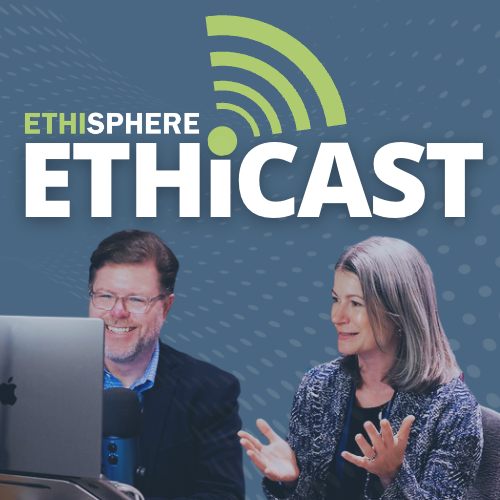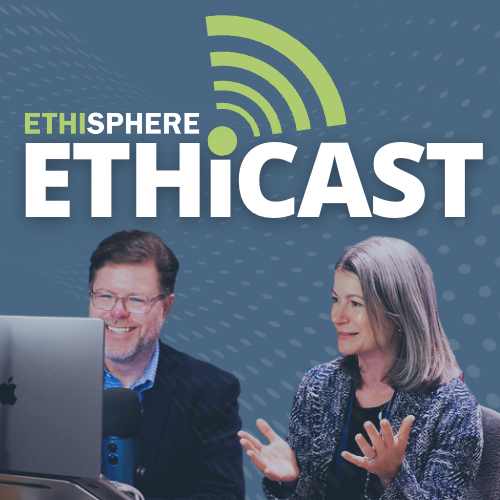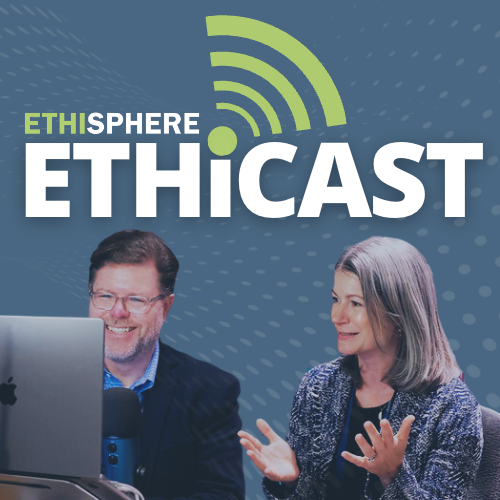Episode Transcript
[00:00:00] Speaker A: Hi everyone. Today we're going to talk about how food company Cargill has modernized how it trains its vast global workforce. I'm your host, Bill Coffin and this is the Ethicast.
Cargill is the largest privately held US Company in terms of revenue.
Based in Minnetonka, Minnesota. It describes itself as, quote, a food company to the world. And even that might be putting it mildly. Its various businesses touch every major aspect of the global food supply chain, including agriculture, animal nutrition, food and beverage production and transportation. It also produces pharmaceuticals supplements, beauty products and bioindustrial products.
It manufactures de icing solutions and industrial salts and trades metals. It offers data asset solutions, risk management services and it provides financial solutions that facilitate trade and mitigate trade related risks for companies doing business in emerging and developed markets.
Cargill employs 160,000 people worldwide, which is more than the entire population of Charleston, South Carolina and it operates in 70 countries, delivering to 125 markets. The company was founded in 1865 on the promise that, quote, our word is our bond. A great place to see that in action is within its ethics and compliance program which already practices what the Department of Justice recommends in its evaluation of corporate compliance programs guidance, namely that a hallmark of a well designed compliance program is appropriately tailored training and communications.
With us today is Christopher Anand, Senior director within Cargill's ethics and compliance office. Among other things, he he is responsible for the company's global mandatory compliance curriculum. Christopher has led a multi year effort to modernize Cargill's online training components to include burst learning modules and to adopt unified deployment strategy to improve learning outcomes and operational efficiency. All this work has paid off in more ways than one. When Cargill underwent a program assessment with Ethisphere earlier this year, the review team noted the high quality of Cargill's training efforts, describing them as quote, unquote excellent. That kind of praise is not easy to come by. Christopher, welcome to the show. I'm looking forward to talking with you about Cargill's E and C training program.
[00:02:23] Speaker B: Thanks so much for having me, Bill. Really looking forward to the conversation.
[00:02:26] Speaker A: Can you talk about how your emphasis on instructional design and program architecture has helped to advance the effectiveness of Cargill's training program?
[00:02:35] Speaker B: Certainly. So from an instructional design perspective, we really place an emphasis on evaluating behavior. That is our goal. So using scenario based knowledge questions, examples that employees can more directly relate to, that will ultimately show how they're applying the knowledge of our policies as opposed to can they prove they know the vocabulary. And it's really this approach that has helped us in a variety of ways. Especially with data coming out of our training program that allows us to pivot to to areas of weakness and to emphasize areas of strength. Overall, from an architecture perspective, we leverage a curriculum approach that means we consider the topics that we want to train, the audience that needs to get those topics, and the cadence of which we want to train. Ultimately putting together a training calendar that will be used to guide our learning efforts throughout our fiscal year. And in terms of building something like that, I mean, there are lots of different influences you can take. I was fortunate that I had parents as teachers, so certainly kind of developing a learning curriculum is a little bit second nature to me. But I would encourage anybody out there that maybe is a little less comfortable in trying to put together a curriculum. Talk to your favorite teacher. If you're still in touch with them, you can make a teacher no happier than having their endorsement of and their help to put together a curriculum for you.
[00:04:15] Speaker A: How would you say the work in your training program has affected other aspects of your E and C program's effectiveness? And do you have any specific examples of where your training produced a positive outcome that really grabbed your attention?
[00:04:28] Speaker B: Yeah. So I mentioned in the response to the first question about data, because really today there's a huge emphasis on how you collect data, but not just the collection, but what do you do with it once you have it. And using question level data that's coming out of training can really drive insights into where your program and your businesses that that program supports may have soft spots.
There's also a lot that you can do with employee data that likely is being shared by your learning management system to help analyze the results by business, by geography, by job type, and comparing that data once you have those results against other data that you have, such as your incident data, your policy access data, all of that together ultimately will paint a picture of the overall health of your program. But as I mentioned before, specific areas of weakness that you may need to take a more concentrated effort to address.
I would say one of the most positive outcomes that we've been able to have is just how targeted you can get in training on a particular topic of interest. Whether it's something that's coming up from the regulatory environment or just an area where you've seen some of that weakness. For us, that's been conflicts of interest.
In the United States and various other geographies, understanding what a conflict of interest is probably isn't that much of a stretch. But we do operate in some other geographies where that might be a little more nuanced and being able to use data to target specific messaging on conflicts, analyzing it to see is the employee audience understanding and if not to the level that we're comfortable with, what supplemental programs can we use to increase that understanding and partnership with the business has been a great exercise for us and something that we've really been able to see the results of better understanding on that topic and some of the geography that we work in.
[00:06:41] Speaker A: You have experience as a technical advisor who has helped the SEC and FINRA's continuing education programs in securities.
How have you applied that unique experience to the training program that you've helped build at Cargill? And what insights can you share on how E and C leaders such as yourself can integrate this kind of external experience into your in house programs?
[00:07:02] Speaker B: And thanks for mentioning that Bill, because I really do need to give credit where credit is due and I think our financial service industry partners don't always get that much credit in the training space. But I would say they really pioneered and refined the idea of scenario based learning in which that program that I belong to was taking members of the industry and having those members present actual problems, things that they saw in their firms, things things that people were tripping up over and then using those examples to form the training that would ultimately be given to licensed individuals, working them through the scenario and actively testing their understanding, in other words, behavior of how to apply a particular policy to a situation.
It's no wonder that that works. Case studies is one of the biggest recommendations that you hear from coming out of assessments of how do take actual incident data from your company, genericize it somewhat, but otherwise share it with the employee audience so that they understand here's something that we can learn from this incident. But oh, by the way, we are paying attention to these things too and it can be a really good way to reinforce learning.
I'd also say outside of your organization, I mean there's a lot of information internally, but outside your organization there's an absolute treasure trove of ideas in the learning space. Usually the only barrier is thinking, well, how do I get it? How do I access it?
Peer groups like Bella through Ethisphere are a great way to be able to share ideas. Networking at conferences and events where you meet other industry peers is a great way to share information.
Vendors often will have library samples that you can look and who knows, maybe find a particular idea from there. It doesn't take much time to find ideas that can inspire in this space.
[00:09:13] Speaker A: You spent a few years building this curriculum. So can you talk about what that process was like, what you learned along the way, and what lessons it's imparted to you that you would bear in mind if you had to do this all over again?
[00:09:26] Speaker B: Yeah, I'd say probably the biggest learning that I can look back on over a multi year journey in designing a full fledged curriculum and thinking of audiences and topics and all of that was that when you start close to zero or when you're looking to make a major redesign of a program, it's very tempting to think that you have to boil the ocean. You've got to do everything at once. And that actually is a very bad strategy. I've learned over time that incremental change will ultimately lead to step change. And what ideally you can do by just making small improvements along the way is bring your organization along with you. With Cargill, it was getting them used to first the number of courses that we were going to have, the length of those courses, when they were going to be deployed, how much time we'd give people to get them done, and what our expectation was with completion rates. We didn't get it all overnight. It took time to get there. But now we feel that we're in a really, really good place. Another recommendation that I'd make, and you mentioned it yourself, is going through a program assessment. And we went through our most recent program assessment not that long ago through Ethisphere, through the compliance leader verification process.
And that even where you feel you are strong, you will get ideas and feedback that you can apply to make things even better, to increase the maturity of your program.
And last but not least, it's tempting to not listen to employee feedback because sometimes the feedback that you get from employees when it comes to compliance training is how they don't like it.
All of us have probably heard that feedback. But even in feedback that may be somewhat critical, there probably is something there that you can use. Because remember, employees are our audience.
That's the main consumer of the training product. And we have to listen to them to make sure it's reaching them in a way that they understand.
[00:11:38] Speaker A: Well, Christopher, thank you so much for sharing your insights with us today. Training is an area in which many compliance programs struggle. And I hope that our friends in the audience will be able to take what they've learned from your example and, and use it to advance their own efforts.
[00:11:51] Speaker B: Bill, it's been a great time. Thanks so much for having me. I'm hoping we can do this again.
[00:11:56] Speaker A: To learn more about Cargill's training program, as well as what Christopher and his team are up to, visit cargill.com and click on the About Us tab. There you can enter the Ethics and Compliance section and connect to the company's guiding principles, its Code of Conduct, its Supplier Code of Conduct, and most importantly, its ethics Open Line.
The Member Resource Hub of the Business Ethics Leadership alliance, or bela, has dozens of training documents contributed by BELA member companies for you to download and use as peer guidance. If you're not yet a BELLA member, visit ethisphere.combella to request guest access to the Member Resource Hub and to speak with a BELLA Engagement Director.
To appear as a guest on this program and share an ethics and compliance best practice or success story, drop us a line at ethisphere.com@thecastle thanks for joining us. We hope you've enjoyed the show. For new episodes each week, be sure to subscribe on YouTube, Apple Podcasts and Spotify. And if you don't mind, please share this with a colleague. It really helps us out. That's all for now, but until next time, remember, strong ethics is good business.


